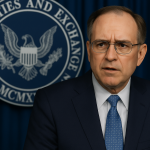The Nasdaq‑listed company formerly known as Leap Therapeutics has surged roughly 300% after announcing a $50 million investment into Zcash (ZEC), backed by Winklevoss Capital. The move is more than a one‑off bet: it signals a growing trend of institutional treasury allocation into crypto assets amid broader market shifts in regulation, macro uncertainty and digital‑asset adoption.
Market Reaction
Shares of Leap Therapeutics (ticker: LPTX) soared by more than 300% within hours of the announcement that the company had acquired 203,775.27 ZEC for approximately $50 million at an average price of $245.37 per token. Zcash itself jumped over 12% in 24 hours to trade in the $520‑$530 range following the disclosure. The magnitude of the move underscores both speculative appetite and genuine interest in corporate balance‑sheet crypto strategies. Traders appear to be treating this not just as a biotech pivot, but as a broader signal of renewed institutional appetite for “privacy‑coin” exposure and corporate digital‑asset treasuries.
Strategic & Regulatory Implications
Leap has rebranded to Cypherpunk Technologies Inc. with a new ticker CYPH, and the $58.88 million private placement led by Winklevoss Capital underpins its shift into digital‑asset treasury management. Beyond the headline news, this move reflects a key structural narrative: companies are increasingly treating crypto holdings as strategic assets rather than purely speculative plays. Zcash, with its optional shielding and zero‑knowledge proof architecture, is positioned as a “privacy hedge” in an era of heightened regulatory scrutiny of public blockchains and transparent ledgers. From a compliance perspective this matters: the dual‑mode design of ZEC may make it more institutionally palatable than mandatory‑privacy coins, offering a route for firms to place crypto on the balance sheet while still addressing regulatory concerns.
Investor Sentiment & Strategic Behaviour
Investor reactions suggest a mix of excitement and caution. On the one hand, allocating $50 million to Zcash signals conviction: the firm aims to acquire up to 5% of ZEC’s total supply according to public commentary. On the other hand, crypto‑treasury plays have previously been met with volatility when token prices or regulatory environments shift. The jump in the stock reflects short‑term momentum and sentiment, but market participants will be watching how the company manages treasury risk, token custody, and disclosure over time. The strategic pivot—from oncology biotech to crypto‑treasury vehicle—also requires behavioral adjustment from both management and investors, signalling a shift in risk appetite and business model orientation.
Forward‑looking, the company must navigate both asset‑performance risk and evolving regulatory standards. Will its Zcash holdings prove a durable store of value or be vulnerable to broader crypto‑market drawdowns?
The firm’s dual identity—continuing its drug‑development operations alongside the crypto treasury—adds complexity and may test investor patience. Equally, the broader crypto market context is not risk‑free: regulation in the U.S. and abroad is tightening, and any headwinds in privacy‑coin policy could knock sentiment.
Nonetheless, for institutional crypto investors, this development raises an important question: as more public companies lean into digital‑asset treasuries, are we entering a new phase where corporate crypto allocation is mainstream rather than fringe? The answer may hinge on how well Cypherpunk executes, how Zcash performs, and whether the broader market environment rewards—or punishes—such strategic pivots.












Leave a comment